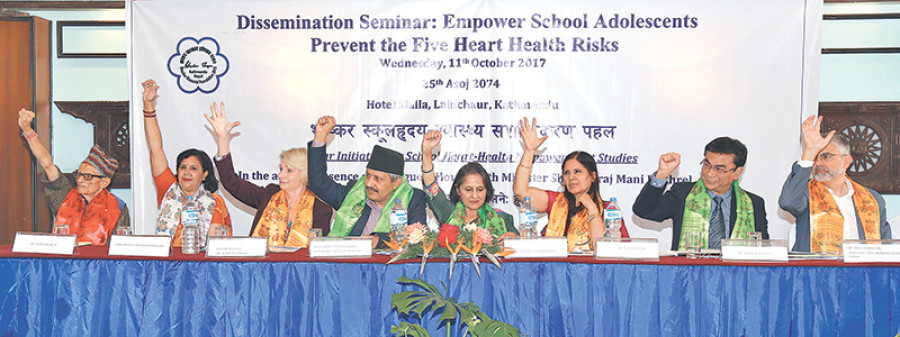Health
Early intervention stressed for prevention of heart diseases
Schools going adolescent are at the highest risk of Cardiovascular Diseases (CVDs), one of the major killers worldwide including one fifth of all deaths in Nepal.
Schools going adolescent are at the highest risk of Cardiovascular Diseases (CVDs), one of the major killers worldwide including one fifth of all deaths in Nepal.
Studies have shown that teenagers, especially those in the age group of 13-17, are the most vulnerable due to their early exposure to primary factors of CVDs like unhealthy lifestyle, alcohol and tobacco consumption and stress, among others.
According to Global School-Based Student Health Survey, Nepal (2015), nearly 85 per cent of children have shown physical inactivity while other 32 per cent become prone to CVDs because of unhealthy diet. Among other reasons leading to CVDs, alcohol and tobacco consumption account for more than 13 per cent children.
The research has pointed out that growing stress at young age have also increased chances of CVDs among children.
Experts have stressed for early awareness among children about healthy lifestyle that can protect them developing heart related diseases in the future. Speaking at the seminar on, “Empower School Adolescents: Prevent the Five Heart Health Risks” on Wednesday, Health Minister Giriraj Mani Pokharel said there should be a campaign to deal with such alarming situation.
“If we can protect this young generation, only then our dream of making a healthy and developed nation will be materialised. We must protect this generation through initiatives aimed at informing them at the very early age,” he said.
At the programme organised by the Bhaskar Memorial Foundation (BMF), a philanthropic organisation established in memory of eminent engineer Bhaskar B Thapa, Rita Thapa, the BMF founding president, said everyone should take responsibility towards combating CVDs.
“CVDs are killing people worldwide and the number is disturbing in Nepal as well. However, the good news is nearly 80 per cent of such deaths can be prevented,” said Thapa. “We aim to protect as many families from such preventable tragedies. It should start with changing behaviour of youths at the early age.”
Experts praised a booklet of modules prepared by the BMF called—the Bhaskar Initiative for School Heart Health Empowerment Studies (BISHES)—that includes informative manuals, especially targeting school adolescents.
The BISHES includes instruction useful for school students in eliminating five major primary risk factors of CVDs—tobacco, alcohol, physical inactivity, stress and unhealthy food.
“BISHES was just a step taken forward towards protecting children from the CVDs risks for now and forever,” added Thapa. The World Health Organisation (WHO) Representative to Nepal, Dr Jos Vandelaer said it was important to target children at the early age before they develop unhealthy behaviours leading to CVDs.
“We decide how we live including whether to smoke, drink or walk or drive; the habits that we develop at the very early age, shape our life forever,” said Vandelaer. “Government can create an enabling environment, but it’s up to us how we live our life. It’s important to observe person’s habits before it becomes too late.”
The BMF baseline survey conducted among schools have shown that children are exposed to CVDs factors. The research has also concluded that school children are informed about the threats but perceive themselves too young to be at the risks of heart related disease.
The BMF, which has already trained teachers and students in schools of Kathmandu Valley, targets to reach schools around the country with preventive messages.
Dr Mahesh Maskey, president of Nepal Public Health Foundation, said schools can be vehicles of the change, taking the message of preventing CVDs widely.
“At the time when non communicable disease are growing threat in comparison to communicable diseases, teaching curative measures to school children can be alternative way to dealing with CVDs,” added Dr Maskey.




 12.12°C Kathmandu
12.12°C Kathmandu













